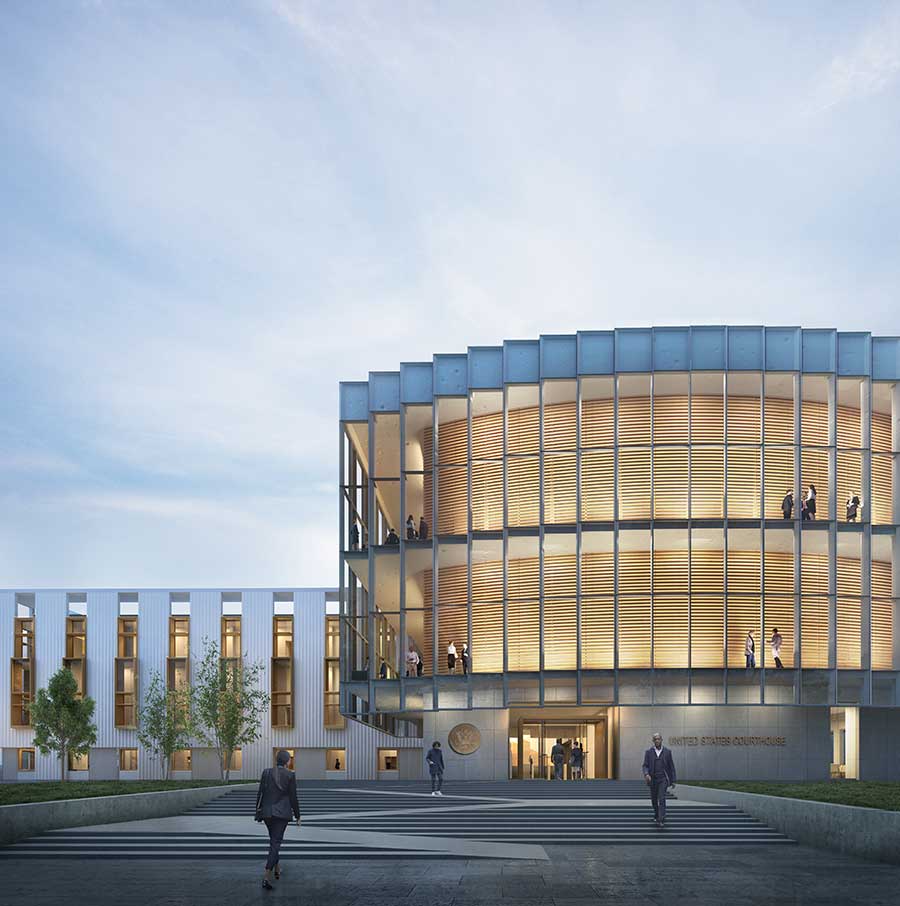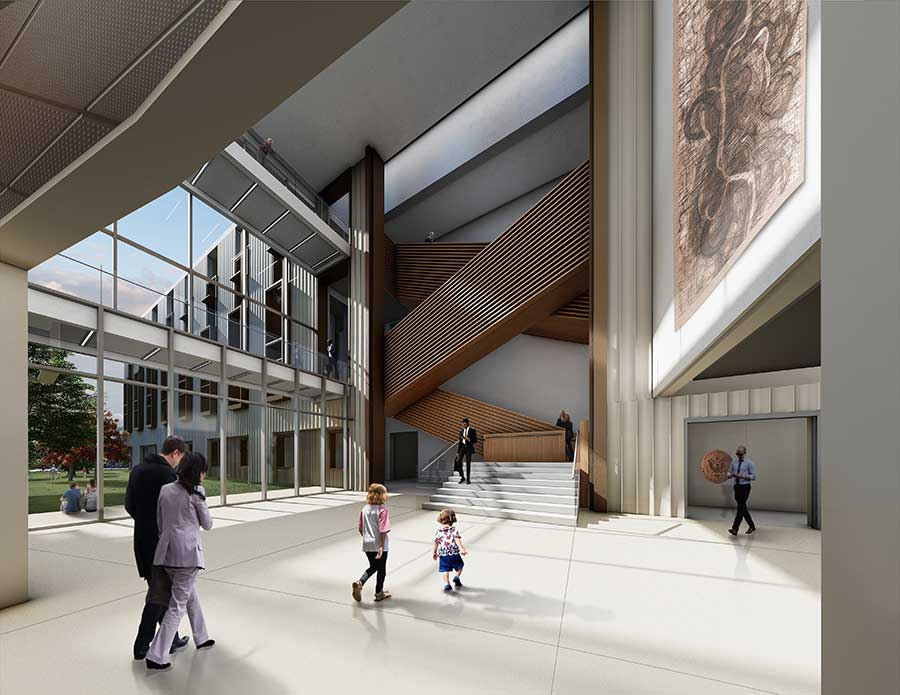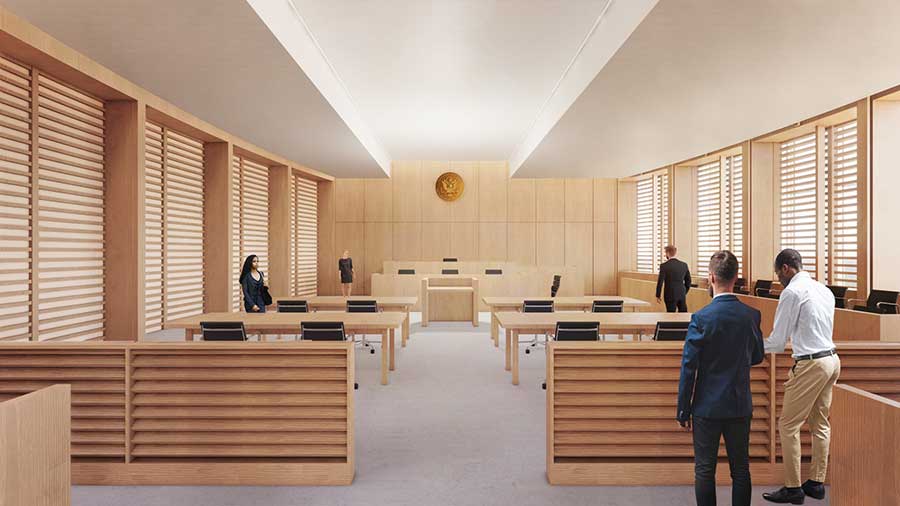


Via Krystal Lamm, operations and marketing director, Duvall Decker Architects: kl@duvalldecker.com
The U.S. General Services Administration (GSA) has approved the design concept for the new U.S. Courthouse in Greenville, Mississippi. The building will provide a much-needed new court facility for the Northern District of Mississippi and will stimulate economic development in the community.
Located at the northern edge of Greenville’s historic district on Washington Avenue, the new functional, secure, and modern building will house the United States Fifth Circuit District and Magistrate Courts, the United States Marshals Service, the United States Probation Office, the GSA Public Buildings Service, the United States Attorney’s Office, and trial preparation space for the federal public defender. The new building is designed to be energy efficient and to achieve LEED Gold and SITES Silver sustainability certifications. Construction is planned to start in mid-2020 with completion in 2022.
The project, part of the GSA Design Excellence Program, is led by Jackson, Mississippi-based architectural firm, Duvall Decker Architects. The co-lead designers are Roy T. Decker, (former MSU School of Architecture faculty member and former director of the Jackson Center) FAIA of Duvall Decker and Steve Dumez, FAIA of Eskew Dumez Ripple. Anne Marie Duvall Decker, FAIA (MSU Alumna and former Eminent Architect of Practice) serves as the design team project manager. Duvall Decker is assisted by a team of consultants including Eskew Dumez Ripple, Dewberry Architects with Michael LeBoeuf, FAIA, Engineering Resource Group, Inc., Walter P. Moore, Newcomb & Boyd, W.L. Burle Engineers, Andropogon, M.A.+ Associates, and Michael Fazio, Ph.D. (MSU School of Architecture emeritus professor).
The goals for the design of the project include creating a southern civic landmark that is meaningful, respectful, progressive, and honors the character and history of the Federal Courts and the City of Greenville, Mississippi.
Meaningful public structures are never fixed in time. They represent who we have been and who we are. They provide the context and cultural conversation of who we want to become.
The project composition has two parts: a long, three-story office building to the south and the courtroom structure, pulled out of the center of the building and set in a civic garden to the north. The office building is characterized by repetitive natural light lenses that invite reflected and indirect light into the interior while limiting the heat and glare of the hot southern sun. The courtroom structure is an inviting figure. Its stacked, shapely, wood-clad courtrooms are visible and veiled by a faceted glass outer skin that is alive in the ever-changing light and weather of each day. The courts become part of the community and open to an ongoing public conversation on the nature and workings of justice.
Meaningful public structures grow from the character of their communities. The design of the U.S. Courthouse in Greenville, Mississippi is connected to its community: its architectural fabric, culture, history, and future plans.
This is a southern building with shady porches overlooking the garden and an interior characterized by indirect “porch” light. The envelope is designed to protect the interior from hot summer heat, humidity, and heavy, wind-driven rains. While it is important for the building to be a civic landmark in the community, the design also finds a fit in the fabric of public buildings nearby, their proportions, scale, patterns, and material palettes.
Meaningful public structures are open and inclusive forms. The design of the U.S. Courthouse in Greenville, Mississippi respects the experiences and aspirations of all of the residents of Greenville.
The architecture of the new U.S. Courthouse in Greenville, Mississippi honors the history and diversity of Greenville with a respectful but contemporary expression and an open, inclusive form. The veiled court structure in the garden invites the community to engage in a living democratic conversation on the nature of the idea of Justice. It is in this quiet way that buildings can be teachers. They can join the legacy of structures telling Greenville’s story and supporting its evolution into the future.
Additional Information
- Duvall Decker: https://www.duvalldecker.com/
- Copies of press release, project information, and high-resolution images: Email Krystal Lamm at kl@duvalldeckercom
- Northern District Press Release: https://www.msnd.uscourts.gov/new-us-courthouse-greenville-mississippi
- GSA Project Status: https://www.gsa.gov/about-us/regions/welcome-to-the-greater-southwest-region-7/buildings-and-facilities/greenville-us-courthouse
- Greenville, Mississippi: https://www.greenvillems.org
_________________________________________________________________________
About Duvall Decker
Jackson, MS based Duvall Decker Architects, P.A. is an architecture firm that is recognized as a design and planning leader in the region. Led by principals Roy Decker and Anne Marie Duvall Decker (MSU School of Architecture alumna), the firm has earned numerous awards for design excellence. Their portfolio includes libraries, military facilities, commercial data centers, hospitality, and housing/urban development for multiple partners. Duvall Decker’s work consistently considers the public aspects of the built environment to produce buildings durable in both material and memory.
About Eskew Dumez Ripple
EskewDumezRipple (EDR) is a New Orleans based architecture, interiors, and urban planning firm recognized for producing innovative projects grounded by a strong understanding of context, culture, and environment. Established in 1989, the studio has transformed from a local firm doing nationally recognized work to a national firm that has retained its local roots. Recipients of the prestigious Architecture Firm Award from the American Institute of Architects, the firm has continued to find meaningful ways to shape community and the profession at large. Building upon the legacy of firm founder Allen Eskew, the firm strives to engage the world as he did—with humility, charm, and a deeply personal commitment to design as craft.
https://www.eskewdumezripple.com/
About the U.S. District Court for the Northern District of Mississippi
The United States District Court for the Northern District of Mississippi has five district judges, three magistrate judges, and two bankruptcy judges, and has three divisions operating out of courthouses in Oxford, Greenville, and Aberdeen, MS. It was created in 1838 when Congress divided Mississippi into two judicial districts.
https://www.msnd.uscourts.gov/court-info/court-locations/Greenville
About the General Services Administration (GSA)
GSA is responsible for delivering much of the space requirements of federal agencies. GSA provides national leadership, policy direction, and standards in the areas of architecture, engineering, urban development, sustainable design, fine arts, historic preservation, construction services, and project management.
To ensure a high standard of excellence for the American public, GSA engages the best private-sector architects and engineers to design, modernize existing, and construct new federal buildings through its internationally renowned Design and Construction Excellence Program.